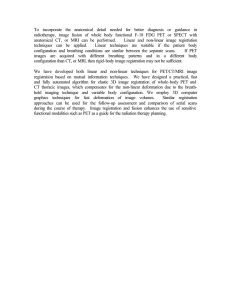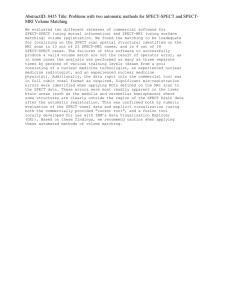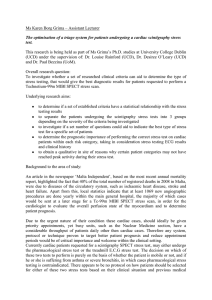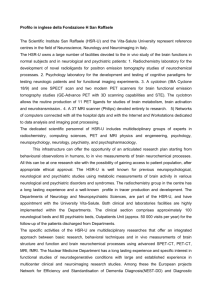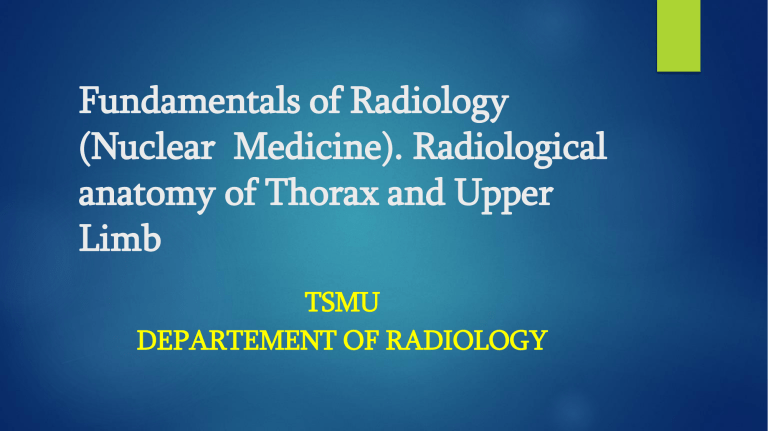
Fundamentals of Radiology (Nuclear Medicine). Radiological anatomy of Thorax and Upper Limb TSMU DEPARTEMENT OF RADIOLOGY What is nuclear medicine? Detection and Subsequent Processing of Radioactive Radiation of Investigated Probe (Human Body or Its Any Tissue Sample) What is Radioactivity? Radioactivity (i.e., radioactive decay) is the process by which unstable atoms that do not have sufficient binding energy to hold their nuclei together emit ionizing radiation. Henri Becquerel discovered spontaneous radioactivity from uranium in 1896, and Pierre and Marie Curie discovered radium and polonium in 1898. As a result, all three received the Nobel Prize in Physics in 1903. Radioactivity (cont) An unstable nucleus will decompose spontaneously, or decay, into a more stable configuration by emitting certain particles (alfa and beta) or certain forms of electromagnetic energy (gamma rays). Radioactive decay is a property of several naturally occurring elements as well as of artificially produced isotopes of the elements. The process continues until a stable nucleus has been formed. Alpha decay Beta decay Gamma decay Alpha decay Alpha particle (identical to a helium nucleus) is emitted. Travel a few centimeters in air. Unable to penetrate the outer layer of dead skin cells. High charge and mass, can cause serious cell injury, if in the body. How? Food or air. Alexander Litvinenko – Poisoned by Polonium-210 Beta decay Beta particle (electron or positron) is emitted. Smaller mass. Travel further in air for few meters. It can penetrate skin a few millimeters. Carl Anderson discovered the positron (the “positive electron”) in 1932 and subsequently received the Nobel Prize in Physics in 1936. Gamma decay Gamma ray does not consist of any particles, unlike its predecessors. Instead consisting of a photon of energy (electromagnetic radiation) being emitted from an unstable nucleus. No mass or charge. Can travel 150 meters. Can be stopped by high atomic value material such as lead. A radioactive compound or Radioisotope. A Radioisotope is an unstable form of an element that emits radiation from its nucleus as it decays. Radioisotopes - artificial and natural. Natural - Uranium and Thorium. Artificial – Induced radioactivity, Radiopharmaceuticals. Irene and Frederic Joliuo-Currie, 1934. Awarded the Nobel Prize for Chemistry for the synthesis of new radioactive isotopes 1935. Radiopharmaceuticals How it works? Any substance might be “marked” by radionuclide (radioisotope), called radiotracer, radiopharmaceutical, or radiopharmacopreparation (RPP), that enables to locate and monitor this substance in the organs and tissues using external detection of emitted β or γ emission. Bones Phospate Radiopharmace uticals Thyroid – Iodine Brain Glucose RPP Has to meet the following requirements: Nontoxic Strong β or γ Emission Relationship to Definite Organ or Tissue (Property of Specific Uptake) Optimum Effective Semiexcretion Period (ESP) Quantitative parameters of radioactive isotops: Half-life period – the period of time, in which radioactivity decreases to the half of initial; Semi-excretion period – the period of time, in which the half of administered RPP is excreted Effective semi-excretion period - the period of time, in which the initial radioactivity of administered RPP is halved due to physical break-up and biological excretion processes Commonly Used Radioisotopes in Diagnostic Nuclear Medicine How are nuclear medicine imaging tests generally performed? We Administer the RPP to the patient RPP is Accumulated by Investigated Organ We can monitor the RPP accumulation and lead out processes We can get the information about RPP distribution in the studied organ and construct it’s image, as well as, receive numerical data (digits) and curves. cont. For Planar scintigraphy and SPECT, gamma rays are emitted by the radioactive isotopes in the radiotracers. For PET, positrons that are emitted by the radioactive isotopes in the radiotracer molecules travel several millimeters within tissue before annihilating with electrons that are encountered, leading to emission of two gamma rays in opposite directions. The gamma rays leave the body, pass through a collimator (in planar scintigraphy and SPECT), and are detected by one or more scintillation crystals in detectors surrounding the patient. The light signals created by the scintillation crystals are then detected by photomultiplier tubes (PMT), which lead to creation of voltage signals that are digitized for computers to process. Gamma rays Collimator Scintillation crystals Photomultiplier tubes Computer Scheme for apparatus of gamma camera system Gamma camera system used in planar scintigraphy What is Planar Scintigraphy? Creates non-tomographic 2D planar images of accumulation of a radiotracer in the body. Performed using a gamma camera system. Mostly used to scan Bone Thyroid Biliary system Lung Full body. MRI, CT and Bone Scintigraphy Increased uptake in the right proximal humerus (red arrows) as well as the apex of the skull (orange arrows). There is also an increased uptake in thyroid gland (Yellow arrows). Computed tomography scan of the right arm showing a mass lesion (red arrow). Magnetic resonance imaging of the head showing an enhancing calvarial mass (marked X) invading into the subcutaneous tissue (red arrow). What is SPECT? Single photon emission computed tomography (SPECT). Several tomographic (cross-sectional) two-dimensional images with multiple two-dimensional angels. Creates three-dimensional images. SPECT/CT (fuses two imaging modalities – CT & Nuclear medicine ) are most often employed for SPECT imaging to provide coregistered molecular and structural images. It also requires the use of a collimator, which generally results in lower sensitivity and poorer image quality compared to PET . Mostly used to scan Brain, Heart, Bone. SPECT (bottom) slices at level of basal ganglia (A) and cerebellum (B) in patient presenting with right middle cerebral artery infarction. (A) SPECT image shows greater extension of ischemia than MRI (yellow arrows). (B) Anatomic representation of cerebellar hemispheres is normal, whereas decreased tracer uptake (hypoperfusion) is seen in left cerebellar hemisphere (white arrowhead). What is PET (Positron emission tomography)? PET creates tomographic (cross-sectional) images of accumulation of a positron emitting radiotracer in the body. Creates three-dimensional images. Nowadays, used with CT and MRI- called PET/CT and PET/MRI (PT/MRI an emerging imaging technology) which provides better molecular and structural images, improving image quality, anatomic localization of sites of radiotracer uptake, and diagnostic performance. . PET/CT and PET/MRI fuses two imaging modalities – CT & Nuclear medicine or MRI & Nuclear medicine PET/CT-MRI Mostly used to Detect cancer, hidden metastasis, staging, follow ups, recurrence. Heart, Bone, Brain. Typical PET/CT scanner with gantry (which contains x-ray tube for CT and scintillation crystals for PET) and patient table. Axial PET, CT, PET-CT, and Planar Scintigraphy images in a patient of lung cancer. a–e. A 59-year-old female patient had therapy for carcinoma of the right breast. She presented with back pain. Bone scintigraphy was performed to rule out bone metastasis. Planar bone scintigraphy images (a, b) Planar scintigraphy shows focal uptake in the L5 vertebra (arrow). (c) Axial SPECT image shows uptake in the region of right facet joint of the L5-S1 vertebrae (arrow). Axial CT (d) and SPECT-CT (e) images show L5-S1 vertebrae right facet joint arthritis with increased tracer uptake (arrow; score 5). On these images, SPECT, CT and SPECT-CT characterized the planar scintigraphy indeterminate lesion as benign Nuclear medicine techniques are used not only for diagnostic purposes, but also less commonly to treat cancer, in which case the radiotracers used accumulate in tumor sites and also emit charged particles that promote cancer cell death. Patient can briefly be the source of radiation exposure to others. Limit exposure Increase distance Shielding Isolation Lastly, how does molecular imaging(NM) differ from structural imaging(X-Ray, CT, MRT, US)? Molecular imaging (Nuclear Medicine) Molecular characterization of normal tissues and disease, even when morphologic changes in tissues have not yet occurred. Radiography, [CT], [MRI], and [US] Assessment of normal tissues and disease based on morphologic and gross functional alterations. ANY QUESTIONES? Thorax Bones and Upper Limb How Can we image it? Conventional X-Ray filming Computed Tomography (CT) Magnetic Resonance Imaging (MRI) Thorax Bones Sternum, Ribs, and Vertebrae 1-7 ribs – True ribs 8–12 ribs - False ribs 11-12 ribs – Floating ribs Joints between ribs and vertebrae 3D Reconstraction of Thorax bones Sternum Sternum on CT and MRI sagittal view Chest X-Ray anteroposterior and lateral. Chest CT coronal slices Upper Limb Bones Scapula Clavicle Humerus Radius and Ulna Carpal bones Metacarpals and Phalanges Shoulders Clavicle. Scapula. Humerus. Shoulder (cont.) Anterior-Posterior View of the Scapula Lateral View of the Scapula Oblique and Anteroposterior View of the Clavicle Axial radiograph of the proximal Humerus Shoulder development X-Ray Shoulder CT Shoulder CT (cont.) Shoulder MRT Shoulder MRT (cont.) Humerus Lateral and Anterior-Posterior View of the Upper Arm Elbow Anterior-Posterior and Lateral View of the Elbow Elbow radiographs, (a) 7-month-old child, (b) 3-year-old child, (c) 6-year-old child, (d) 9-year-old child Forearm Hand and Wrist Hand and Wrist Bones of the hand (dorsopalmar radiographs), (a) of a 10-month-old child, (b) of a 2year-old child, (c) of a 6-year-old child, (d) of a 9-year-old child,toillustratecentresofossification,(e) of an 11-year-old child. Elbow MRT Forearm MRT and CT Wrist CT and MRT ANY QUESTIONES?
